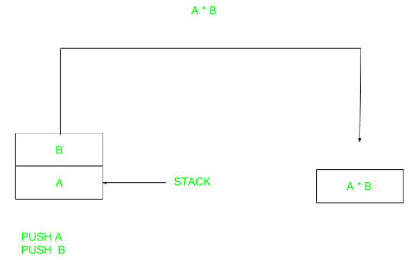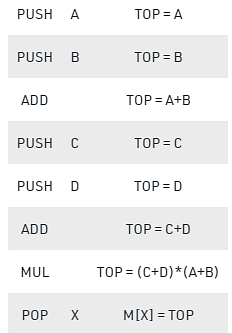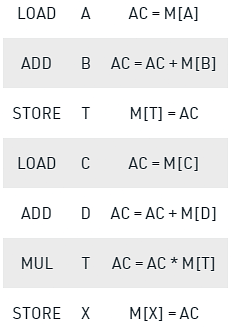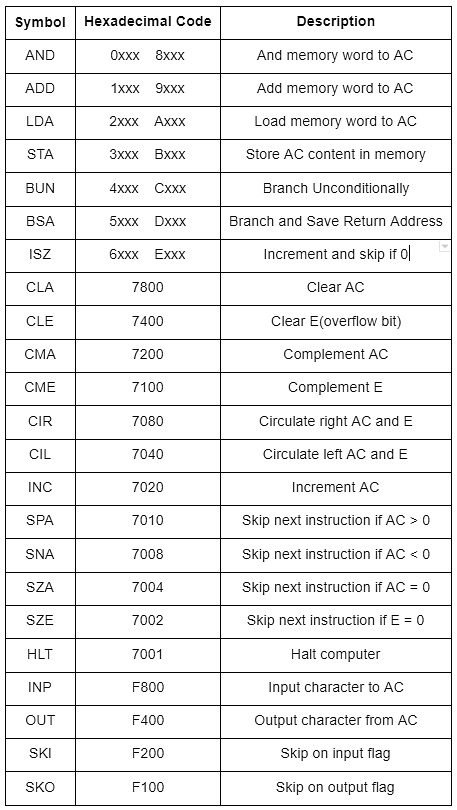Basic Computer Instructions | Computer Architecture & Organisation (CAO) - Computer Science Engineering (CSE) PDF Download
Computer Organization
The basic computer has 16-bit instruction register (IR) which can denote either memory reference or register reference or input-output instruction.
1. Memory Reference: These instructions refer to memory address as an operand. The other operand is always accumulator. Specifies 12-bit address, 3-bit opcode (other than 111) and 1-bit addressing mode for direct and indirect addressing.

Example: IR register contains = 0001XXXXXXXXXXXX, i.e. ADD after fetching and decoding of instruction we find out that it is a memory reference instruction for ADD operation.
Hence, DR ← M[AR]
AC ← AC + DR, SC ← 0
2. Register Reference: These instructions perform operations on registers rather than memory addresses. The IR(14 – 12) is 111 (differentiates it from memory reference) and IR(15) is 0 (differentiates it from input/output instructions). The rest 12 bits specify register operation.
Example: IR register contains = 0111001000000000, i.e. CMA after fetch and decode cycle we find out that it is a register reference instruction for complement accumulator.
Hence, AC ← ~AC
3. Input/Output: These instructions are for communication between computer and outside environment. The IR(14 – 12) is 111 (differentiates it from memory reference) and IR(15) is 1 (differentiates it from register reference instructions). The rest 12 bits specify I/O operation.
Example: IR register contains = 1111100000000000, i.e. INP after fetch and decode cycle we find out that it is an input/output instruction for inputing character. Hence, INPUT character from peripheral device.
The set of instructions incorporated in16 bit IR register are:
- Arithmetic, logical and shift instructions (and, add, complement, circulate left, right, etc)
- To move information to and from memory (store the accumulator, load the accumulator)
- Program control instructions with status conditions (branch, skip)
- Input output instructions (input character, output character)

Instruction Formats (Zero, One, Two and Three Address Instruction)
Computer perform task on the basis of instruction provided. An instruction in computer comprises of groups called fields. These field contains different information as for computers every thing is in 0 and 1 so each field has different significance on the basis of which a CPU decide what to perform. The most common fields are:
- Operation field which specifies the operation to be performed like addition.
- Address field which contain the location of operand, i.e., register or memory location.
- Mode field which specifies how operand is to be founded.
An instruction is of various length depending upon the number of addresses it contain. Generally CPU organization are of three types on the basis of number of address fields:
- Single Accumulator organization
- General register organization
- Stack organization
In first organization operation is done involving a special register called accumulator. In second on multiple registers are used for the computation purpose. In third organization the work on stack basis operation due to which it does not contain any address field. It is not necessary that only a single organization is applied a blend of various organization is mostly what we see generally.
On the basis of number of address, instruction are classified as:
Note that we will use X = (A+B)*(C+D) expression to showcase the procedure.
1. Zero Address Instructions:
 A stack based computer do not use address field in instruction. To evaluate a expression first it is converted to revere Polish Notation i.e. Post fix Notation.
A stack based computer do not use address field in instruction. To evaluate a expression first it is converted to revere Polish Notation i.e. Post fix Notation.
Expression: X = (A+B)*(C+D)
Postfixed : X = AB+CD+*
TOP means top of stack
M[X] is any memory location

2. One Address Instructions:
This use a implied ACCUMULATOR register for data manipulation. One operand is in accumulator and other is in register or memory location. Implied means that the CPU already know that one operand is in accumulator so there is no need to specify it.
Expression: X = (A+B)*(C+D)
AC is accumulator
M[ ] is any memory location
M[T] is temporary location

3. Two Address Instructions:
This is common in commercial computers. Here two address can be specified in the instruction. Unlike earlier in one address instruction the result was stored in accumulator here result cab be stored at different location rather than just accumulator, but require more number of bit to represent address.
Here destination address can also contain operand.
Expression: X = (A+B)*(C+D)
R1, R2 are registers
M[ ] is any memory location

4. Three Address Instructions:
This has three address field to specify a register or a memory location. Program created are much short in size but number of bits per instruction increase. These instructions make creation of program much easier but it does not mean that program will run much faster because now instruction only contain more information but each micro operation (changing content of register, loading address in address bus etc.) will be performed in one cycle only.

Expression: X = (A+B)*(C+D)
R1, R2 are registers
M[ ] is any memory location
|
20 videos|86 docs|48 tests
|
FAQs on Basic Computer Instructions - Computer Architecture & Organisation (CAO) - Computer Science Engineering (CSE)
| 1. What are the different types of instruction formats in computer organization? |  |
| 2. How do zero address instructions work in computer organization? |  |
| 3. What is the advantage of using three address instructions in computer organization? |  |
| 4. How are one address instructions executed in computer organization? |  |
| 5. What is the role of instruction formats in computer organization? |  |
|
20 videos|86 docs|48 tests
|

|
Explore Courses for Computer Science Engineering (CSE) exam
|

|


















